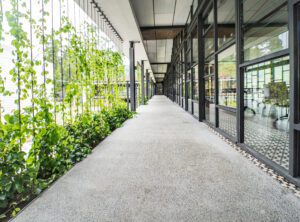Biophilia & Sustainability Continue To Be The Key Focus In Commercial Interior Design

<?xml encoding=”utf-8″ ??>
In recent years, the world has seen a growing trend towards sustainable living and a renewed interest in our connection to nature.
This shift has also been reflected in commercial interior design, where the use of biophilic and sustainable design principles have become increasingly popular.
Key trends for commercial spaces in 2023
One of the key trends is biophilia, which involves incorporating natural elements such as plants and natural light into interior spaces. This approach promotes a connection to nature and improves wellbeing for building occupants. As well as biophilia, sustainability is another key commercial design trend that isn’t going out of style anytime soon. To help create healthy work environments, sustainable interiors focus on using eco-friendly materials and energy-efficient systems to reduce waste and energy consumption.
This approach not only benefits the environment but also reduces operating costs. On top of this, mental health and wellness are becoming a top priority in commercial design, with an emphasis on creating spaces that promote relaxation, comfort, and calmness.
What is sustainability?
According to a quick Google search, sustainability in the broadest sense is about ‘the ability to maintain or support a process continually over time’. One focus is on environmental sustainability, which seeks to look after the environment more so it is in a better condition for generations to come.
Sustainability has become an increasingly important consideration in commercial interior design, with businesses looking into how to reduce their environmental impact. With the rise of environmental concerns and the desire for more responsible business practices, companies are looking for ways to create sustainable and eco-friendly spaces.
How can sustainability be incorporated into commercial design?
One way to incorporate sustainability in commercial interior design is through the use of eco-friendly materials. This includes materials that are sustainably sourced, such as bamboo, cork, or reclaimed wood, as well as those that are non-toxic and low-emission, such as paints and adhesives.
Another way to promote sustainability is by focusing on energy efficiency. This can be achieved through the use of energy-efficient lighting, heating, and cooling systems, as well as the installation of smart systems that can automatically adjust lighting and temperature based on occupancy.
Reducing waste is also a key aspect of sustainable interior design. This can be achieved through the use of durable and long-lasting materials, as well as the implementation of recycling programs for materials such as paper, plastic, and electronics.
Finally, sustainable interior design can also include the incorporation of biophilic elements, as mentioned above. This not only promotes a connection to nature, but it can also reduce energy consumption by maximising natural lighting and ventilation.
The benefits of a sustainable commercial interior
Incorporating sustainability in commercial interior design not only benefits the environment, but it can also lead to cost savings in the long run. By reducing energy consumption and waste, businesses can save money on utility bills and reduce their carbon footprint. This can also help to attract and retain environmentally-conscious customers and employees.
What is biophilia?
Biophilia refers to the innate human connection to nature and the natural world. This connection has been shown to have a positive impact on human health and wellbeing, including reducing stress levels and improving cognitive function. In commercial interior design, incorporating biophilic elements can improve the overall environment and experience for employees and customers.
How can biophilia be incorporated into interior design?
One way to integrate biophilia in commercial interior design is through the use of natural materials such as wood, stone, and plants. Incorporating living plants, both large and small, can bring a sense of calm and tranquillity to the space, while also improving air quality. Natural lighting can also be used to create a more inviting and energising environment, with windows and skylights providing a connection to the outside world.
The use of nature-inspired artwork and patterns is also a significant way to incorporate a biophilic design. Wall murals or wallpaper featuring nature scenes, or textiles with floral or leaf patterns can create a sense of connection to the natural world. Similarly, the use of natural colours such as greens and blues can also evoke a sense of calm and relaxation.
Another popular way to incorporate biophilic design principles into commercial design is through natural elements. By integrating natural features such as plants and natural light, designers can create spaces that promote a connection to nature and improve the wellbeing of building occupants. A prime example of this can be seen in the use of natural stone tiles that can be used in commercial pool design. Natural tiles can not be damaged by the sun making them a great choice for the design, providing an aesthetic appeal as well as allowing a biophilic feel.
The benefits of a biophilic commercial interior
Incorporating biophilia in commercial interior design not only benefits employees and customers, but it can also have a positive impact on the bottom line. Research has shown that businesses with biophilic design elements have higher employee productivity and satisfaction, and customers are more likely to return to a business with a welcoming and calming environment. Overall, incorporating biophilic design elements can be a win-win for both businesses and their stakeholders.




